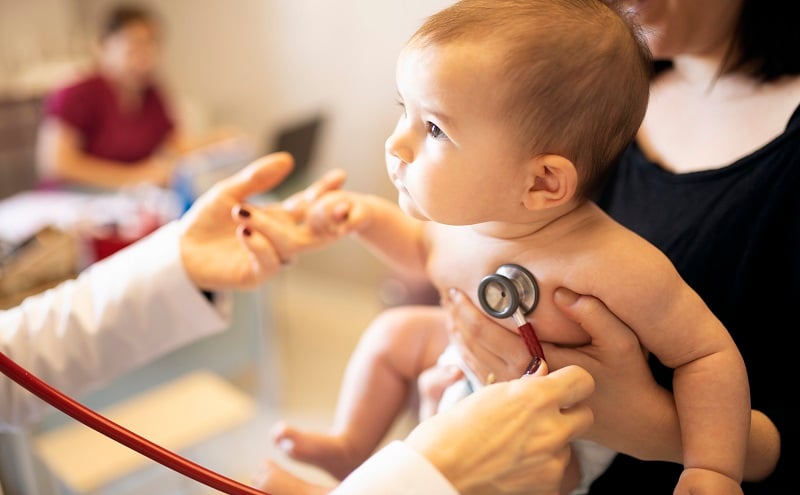
Pulmonary Hypertension in the Pediatric Emergency Department
Andrew Shieh, MD
University of Michigan Medical Center
Traditionally, pediatric pulmonary hypertension was rare, and many clinicians were unfamiliar with the condition. With the advent of medical advancements, the survival rate of children with pulmonary hypertension has improved, and it is likely that a physician will encounter a child with pulmonary hypertension in the emergency department (ED).
Pulmonary hypertension does not refer to a specific disease, but rather a clinical manifestation secondary to another condition resulting in increased pulmonary vascular resistance and elevated right ventricular pressure, which progressively leads to right heart failure.1,2 Pulmonary hypertension develops from a combination of mechanisms including developmental interruption of pulmonary vasculature, destruction from inflammation, and imbalance of vasodilators and vasoconstrictors.1,2 The classification of pulmonary hypertension has changed in the past few decades and, currently, there is no validated system specific to pediatrics.2,3 An idiopathic etiology accounts for most cases.4–6 Bronchopulmonary pulmonary dysplasia affects the remodeling of the pulmonary vasculature.2,6 Congenital and acquired heart disease occur more frequently in children compared to adults and causes alterations in pulmonary vasculature and blood flow through shunt lesions.5–7 Congenital diaphragmatic hernia causes developmental arrest of the lung. Pulmonary hypertension also increases morbidity and mortality in those with hypercoagulable diseases, sickle cell disease, cystic fibrosis, Down syndrome, and connective tissue disorders.2,8
When well, children with pulmonary hypertension may have no symptoms, and clinical suspicion for active disease may be low due to subtle symptoms that mirror other common diagnoses (ex, bronchiolitis, asthma, pneumonia). Symptoms of pulmonary hypertension include dyspnea with exertion, fatigue, and cyanosis with exertion or rest.6 Older children may complain of dizziness, palpitations, syncope with exertion, or chest pain.1,6 Fluid retention, hepatic congestion, and intestinal hypoperfusion cause abdominal pain.6 The physical examination can range from normal to overt signs of right heart failure including a hyperdynamic right ventricular impulse, loud second heart sound (S2), holosystolic tricuspid regurgitation murmur, or diastolic pulmonary regurgitation murmur.4,9 When children with pulmonary hypertension are ill, there is increased metabolic demand and significant decrease in pulmonary blood flow. As a result, the sympathetic system is activated and causes tachycardia with increased systemic vascular resistance. Pulmonary hypertensive crisis should be suspected in children with tachycardia, hypotension, hypoxia, signs of poor perfusion, and altered mental status.4
When evaluating these patients in the ED, other associated conditions such as myocarditis, pulmonary embolism, thoracic mass, and renal failure should be ruled out. Bloodwork may include a complete blood cell count, complete metabolic panel, urinalysis, troponin, and brain natriuretic peptide. An electrocardiogram (ECG) should be obtained to evaluate for right axis deviation, right atrial enlargement, and right ventricular hypertrophy.1 A chest x-ray (CXR) may reveal cardiomegaly, enlarged pulmonary arteries, and reduced peripheral pulmonary vascularity.1 When a child has an abnormal examination, ECG, or CXR, but no signs of right heart failure, a discussion with a pediatric cardiologist can help facilitate echocardiography.1 Children with evidence of right heart failure are at risk for life-threatening cardiopulmonary events, and care should be coordinated with a pediatric cardiologist while transfer to a pediatric intensive care unit capable of delivering inhaled nitric oxide (iNO) is arranged.
Children with known pulmonary hypertension are usually followed by a pediatric cardiologist who should be contacted during the child’s ED visit. Fluid balance requires careful management because hypovolemia worsens pulmonary hypertension and decreases preload, while fluid overload impairs heart function and leads to venous congestion. Rehydration should be performed slowly in 5 to 10 mL/kg quantities, with careful monitoring for signs of heart failure.1 Oxygen should be administered to maintain oxygen saturation above 95%. Children with a central line should be evaluated for signs of sepsis. In children with continuous infusion of epoprostenol, which has a half-life of 4 minutes, interruption of the infusion causes severe pulmonary hypertensive crisis.1 It is crucial to obtain intravenous access and resume the infusion as fast as possible. Treprostinil has a half-life of 4.5 hours and should be restarted peripherally until central access can be safely obtained again.1
Pulmonary hypertensive crisis is the most severe emergency and occurs when there is a sudden rapid rise in pulmonary vasculature resistance leading to acute right heart failure. The significant drop in cardiac output compromises blood flow to the coronary arteries, which worsens right ventricular function. This vicious cycle leads to bradycardia and eventually asystole.1 Crisis can be triggered by stressors such as infection, recent surgery or anesthesia, dehydration, or nonadherence to daily medications. Early consultation with a pediatric cardiologist is recommended to collaborate care. Oxygen should be given to prevent hypoxia. Fluids should be managed carefully, as large volumes can worsen right ventricular dysfunction. Bradycardia should be avoided because cardiac output is heart rate dependent, and chronotropic agents with beta agonist activity may be necessary. Peripheral inotropic agents including epinephrine or dopamine may be required to maintain blood pressure in severe cases. iNO can be given through a nasal cannula and should be started at 20 parts per million. Sildenafil, which can potentiate the vasodilator effect of iNO, should be administered to children who are able to protect their airway.5 Inhaled prostanoids can also be used in the acute setting, but should be administered only after consultation with a pediatric cardiologist.9 Sedation and intubation should only be performed in emergent situations due to increased mortality and known risk for pulmonary hypertension crisis.1 Sodium bicarbonate can be given to correct severe metabolic acidosis. Cardiac arrest is managed through pediatric advanced life support, and extracorporeal membrane oxygenation (ECMO) may be indicated in special cases.
Pediatric pulmonary hypertension is associated with elevated pulmonary artery pressure, which can result in right heart failure. Children with known pulmonary hypertension require emergent evaluation and frequent reevaluation after each intervention in the ED. Emergent treatment options for pulmonary hypertensive crisis are discussed above and should be managed in conjunction with a pediatric cardiologist.
References
- Del Pizzo J, Hanna B. Emergency Management of Pediatric Pulmonary Hypertension. Pediatr Emerg Care. 2016;32(1):49-55. doi:10.1097/PEC.0000000000000674
- Cerro MJD, Abman S, Diaz G, et al. A consensus approach to the classification of pediatric pulmonary hypertensive vascular disease: Report from the PVRI Pediatric Taskforce, Panama 2011. Pulm Circ. 2011;1(2):286-298. doi:10.4103/2045-8932.83456
- Simonneau G, Gatzoulis MA, Adatia I, et al. Updated clinical classification of pulmonary hypertension. J Am Coll Cardiol. 2013;62(25 Suppl):D34-41. doi:10.1016/j.jacc.2013.10.029
- Moledina S, Hislop AA, Foster H, Schulze-Neick I, Haworth SG. Childhood idiopathic pulmonary arterial hypertension: a national cohort study. Heart. 2010;96(17):1401-1406. doi:10.1136/hrt.2009.182378
- Rosenzweig EB, Abman SH, Adatia I, et al. Paediatric pulmonary arterial hypertension: updates on definition, classification, diagnostics and management. Eur Respir J. 2019;53(1):1801916. doi:10.1183/13993003.01916-2018
- Berger RMF, Beghetti M, Humpl T, et al. Clinical features of paediatric pulmonary hypertension: a registry study. Lancet. 2012;379(9815):537-546. doi:10.1016/S0140-6736(11)61621-8
- Li L, Jick S, Breitenstein S, Hernandez G, Michel A, Vizcaya D. Pulmonary arterial hypertension in the USA: an epidemiological study in a large insured pediatric population. Pulm Circ. 2017;7(1):126-136. doi:10.1086/690007
- Abman SH, Raj U. Towards improving the care of children with pulmonary hypertension: The rationale for developing a Pediatric Pulmonary Hypertension Network. Prog Pediatr Cardiol. 2009;27(1-2):3-6. doi:10.1016/j.ppedcard.2009.09.002
- Rosenzweig EB, Feinstein JA, Humpl T, Ivy DD. Pulmonary arterial hypertension in children: Diagnostic work-up and challenges. Prog Pediatr Cardiol. 2009;27(1):4-11. doi:10.1016/j.ppedcard.2009.09.003


